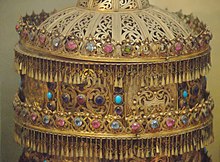Music and art is very popular in Ethiopia. Music in the
county of Ethiopia is very diverse because every ethnic group in the area is
connected with a specific unique sound. The county had many different types of instruments
as well. Traditional string instruments include the Masenqo which was a
single-stringed bowed lute. Another string instrument they used frequently used
was the Begena, it is a ten string instrument that looks similar to the harp we
are familiar with in our county. Other types of instrument include the Washint
which is a bamboo flute, the Kebero which is a very large hand drum. The Ethiopian
people are very influenced by many types of folk music and ancient Christian related
music. The people also listen to their own secular music that is similar to
what we have here in the U.S.
Ethiopian art started as early as the 4th century
to the present. The Art can be divided into 2 separate groups: Christian art
which was used in church and metal work such as crowns. And arts and crafts
such as baskets and jewelry. Ethiopian paintings were done regularly on walls,
books and in icons. The Ethiopians would paint their orthodox churches from top
to bottom. As I said before metal works was another important art form in this
county. They would make crossed out of wood and metal. The crosses were made for
either processional services or worn as jewelry such as necklaces. The Ethiopians
also created a diverse array of textiles used in the church such as curtains
and wrapping in their churches. They also made colorful beautiful baskets which
was extremely common in rural Ethiopia. The people used these baskets to store
grain, seeds, food and also used as bowls.








